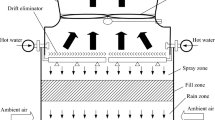Abstract
Present study exhibits an experimental examination of mass transfer coefficient and evaporative effectiveness of a falling film evaporator. Further, a statistical replica is extended in order to have optimal controlling parameters viz. non-dimensional enthalpy potential, film Reynolds number of cooling water, Reynolds number of air and relative humidity of up-streaming air. The models not only give an optimal solution but also help in establishing a correlation among controlling parameters. In this context, response surface methodology is employed by aid of design of experiment approach. Later, the response surface curves are studied using ANOVA. Finally, the relations established are confirmed experimentally to validate the models. The relations thus established are beneficent in furtherance of designing evaporators. Additionally, the present study is among the first attempts to reveal the effect of humidity on the performance of falling film evaporator.







Similar content being viewed by others
References
Abraham R and Mani A 2014 Experimental studies on thermal spray-coated horizontal tubes for falling film evaporation in multi-effect desalination system. Desalination Water Treatment (ahead-of-print): 1–12
Bustamante J G 2014 Falling-film evaporation over horizontal rectangular tubes
Christians M and Thome J R 2012 Falling film evaporation on enhanced tubes, part 1: Experimental results for pool boiling, onset-of-dryout and falling film evaporation. Int. J. Refrigeration 35(2): 300–312
Chyu M-C and Bergles A 1987 An analytical and experimental study of falling-film evaporation on a horizontal tube. J. Heat Transfer 109(4): 983–990
Fernández-Seara J and Pardiñas Á Á 2014 Refrigerant falling film evaporation review: Description, fluid dynamics and heat transfer. Appl. Therm. Eng. 64(1): 155–171
Gonda A, Lancereau P et al 2014 Water falling film evaporation on a corrugated plate. Int. J. Therm. Sci. 81: 29–37
Gong L, Shen S et al 2015 Three-dimensional heat transfer coefficient distributions in a large horizontal-tube falling film evaporator. Desalination 357: 104–116
Monnier H, Portha J-F et al 2012 Intensification of heat transfer during evaporation of a falling liquid film in vertical microchannels—Experimental investigations. Chem. Eng. Sci. 75: 152–166
Ribatski G and Jacobi A M 2005 Falling-film evaporation on horizontal tubes—A critical review. Int. J. Refrigeration 28(5): 635–653
Sharma S, Rangaiah G et al 2012. Multi-objective optimization using MS Excel with an application to design of a falling-film evaporator system. Food Bioproducts Process. 90(2): 123–134
van Rooyen E and Thome J 2014 Flow boiling data and prediction method for enhanced boiling tubes and tube bundles with R-134a and R-236fa including a comparison with falling film evaporation. Int. J. Refrigeration 41: 60–71
Yang L, Xu Z et al 2014 Characterization of the microscopic mechanics in falling film evaporation outside a horizontal tube. Desalination Water Treatment (ahead-of-print): 1–6.
Zeng X, Quek C X et al 2014 Falling film evaporation characteristics of microalgae suspension for biofuel production. Appl. Therm. Eng. 62(2): 341–350
Yang L and Shen S 2008. Experimental study of falling film evaporation heat transfer outside horizontal tubes. Desalination 220(1): 654–660
Myers R H, Montgomery D C et al 2009 Response surface methodology: process and product optimization using designed experiments, John Wiley & Sons
Alhusseini A A, Tuzla K et al 1998 Falling film evaporation of single component liquids. Int. J. Heat Mass Transfer 41(12): 1623–1632
Armbruster R and Mitrovic J 1998 Evaporative cooling of a falling water film on horizontal tubes. Exp. Thermal Fluid Sci. 18(3): 183–194
Weiland P S 1994 National Environmental Policy Act of 1969. U.S.C. 42: 102–105
Kim D and Infante Ferreira C 2009 Flow patterns and heat and mass transfer coefficients of low Reynolds number falling film flows on vertical plates: Effects of a wire screen and an additive. Int. J. Refrigeration 32(1): 138–149
Di Natale F and R Nigro 2012 A critical comparison between local heat and mass transfer coefficients of horizontal cylinders immersed in bubbling fluidised beds. Int. J. Heat Mass Transfer 55(25): 8178–8183
Rana R, Charan V et al 1986 Heat and mass transfer from a horizontal tube of an evaporative heat dissipator. Int. J. Heat Mass Transfer 29(4): 555–562
Prost J, González M et al 2006 Determination and correlation of heat transfer coefficients in a falling film evaporator. J. Food Eng. 73(4): 320–326
Webb R L 1981 The evolution of enhanced surface geometries for nucleate boiling. Heat Transfer Eng. 2(3–4): 46–69
Webb R L and Kim N-H 1994 Principl of enhanced heat transfer, New York, Wiley
Habert M 2009 Falling film evaporation on a tube bundle with plain and enhanced tubes.
Kumar R 2014 Enhancement in evaporative effectiveness of an evaporative tubular heat dissipator using experimental design approach. Heat Transfer—Asian Research
Baldeaux J and Gnewuch M 2014 Optimal randomized multilevel algorithms for infinite-dimensional integration on function spaces with ANOVA-type decomposition. SIAM J. Numer. Anal. 52(3): 1128–1155
Cardinal R N and Aitken M R 2013 ANOVA for the behavioral sciences researcher, Psychology Press
Gu C 2013 Smoothing spline ANOVA models, Springer
Kang E L and Cressie N 2013 Bayesian hierarchical ANOVA of regional climate-change projections from NARCCAP Phase II. Int. J. Appl. Earth Observation Geoinformation 22: 3–15
Acknowledgment
The authors gratefully acknowledge the infrastructure and test facility provided by the National Institute of Technology, Kurukshetra, India.
Author information
Authors and Affiliations
Corresponding author
Appendices
Nomenclature
- EE :
-
evaporative effectiveness
- EP :
-
enthalpy potential
- K :
-
mass transfer coefficient, kg/m2s
- m:
-
mass flow rate, kg/s
- Re :
-
Reynolds number
- t:
-
temperature, °C
Greek symbols
- ϕ:
-
relative humidity, %
Subscripts
- a:
-
air
- av:
-
average
- c:
-
tube surface
- dl:
-
non-dimensional
- h:
-
hot water
- w:
-
cooling water
- 1:
-
inlet
- 2:
-
outlet
Rights and permissions
About this article
Cite this article
Kaushal, R., Kumar, R. & Vats, G. Experimental and numerical analysis for optimal design parameters of a falling film evaporator. Sādhanā 41, 643–652 (2016). https://doi.org/10.1007/s12046-016-0502-y
Received:
Revised:
Accepted:
Published:
Issue Date:
DOI: https://doi.org/10.1007/s12046-016-0502-y




